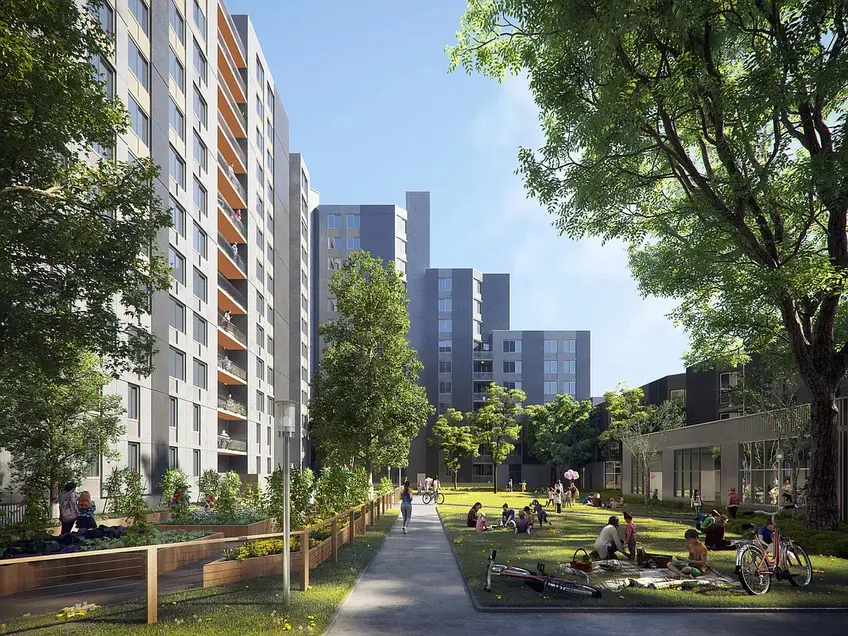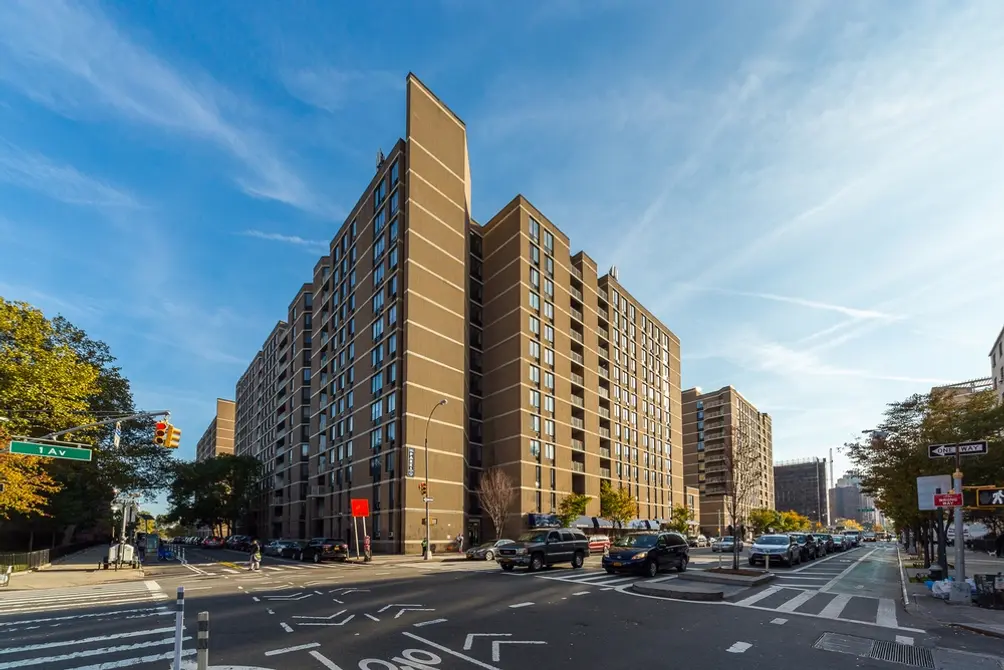 All images of The Crossing via C+C Management
All images of The Crossing via C+C Management
Over the past several months, much of the conversation about affordable housing in New York has revolved around either constructing new buildings or the faint possibility of converting empty commercial buildings into residential. However, the maintenance and rehabilitation of the city’s existing affordable stock is another important aspect coming into focus as their buildings continue to age and degrade.
The New York City Housing Authority’s (NYCHA) Permanent Affordability Commitment Together (PACT) program was devised to bring repairs and renovations to NYCHA communities through a partnership with private and non-profit development partners. The developers are included in the federal government’s Rental Assistance Demonstration (RAD), which unlocks (via Section 8 vouchers) access to bank loans and streams of money that were not previously available to housing authorities. While the developers conduct repairs and serve as on-site property managers, NYCHA continues to own the land and the buildings.
The New York City Housing Authority’s (NYCHA) Permanent Affordability Commitment Together (PACT) program was devised to bring repairs and renovations to NYCHA communities through a partnership with private and non-profit development partners. The developers are included in the federal government’s Rental Assistance Demonstration (RAD), which unlocks (via Section 8 vouchers) access to bank loans and streams of money that were not previously available to housing authorities. While the developers conduct repairs and serve as on-site property managers, NYCHA continues to own the land and the buildings.
The Bronx development Baychester Houses is a prime example of what the PACT program can do. The buildings date back to the 1960s and were plagued by leaks, mold, and poorly attended security. However, after the PACT program, the apartments have new kitchen appliances and bathroom fixtures while the buildings have been re-clad with waterproof and more attractive materials. Security has been enhanced, and the buildings all have new lobbies, hallway lighting, and recycling rooms.
The grounds of Baychester Houses are now home to a refurbished playground, new plantings, a new basketball court, and a GrowNYC farmer’s market. Residents and neighbors have all been impressed by the changes; and seeing its success, earlier this month, NYCHA released a Request for Expressions of Interest to attract development partners for new projects in Manhattan and the Bronx under the PACT program.
The grounds of Baychester Houses are now home to a refurbished playground, new plantings, a new basketball court, and a GrowNYC farmer’s market. Residents and neighbors have all been impressed by the changes; and seeing its success, earlier this month, NYCHA released a Request for Expressions of Interest to attract development partners for new projects in Manhattan and the Bronx under the PACT program.
“The renovations and changes have transformed our community” - Sandra Gross, Resident Association President, Baychester Houses
In addition to improving the quality of life for residents, the repairs under the PACT program have undeniable environmental benefits. Recladding the buildings and replacing the roofs at Baychester and Murphy Houses allows for better insulation, and the apartment enhancements also include new windows and low-flow plumbing fixtures. If a PACT partner felt so inclined, they could even add a Passive House envelope to bring the buildings to a new level of energy efficiency.
 The Crossing (formerly known as River Crossing) prior to renovation (C+C Management)
The Crossing (formerly known as River Crossing) prior to renovation (C+C Management)
 After the exterior retrofit now well underway (C+C Management)
After the exterior retrofit now well underway (C+C Management)
The Crossing in East Harlem is another example of the success of the PACT program. When this 700-unit complex was built in 1980, it was known as River Crossing and part of the Mitchell-Lama affordable housing program. The building was removed from Mitchell-Lama in 2005; but when L+M Development and Invesco Real Estate bought the property in 2019, they agreed to preserve the affordable housing units for an additional 40 years. Soon after, a series of major capital improvements both inside and out commenced.
Current availabilities at The Crossing start at $3,010/month for three-bedrooms and $3,121/month for four-bedrooms. The prices are net effective to reflect a rent concession of 1.5 months free rent on a 16-month lease, and roughly in line with the median rents for similarly sized units in East Harlem (per CityRealty listings).
New amenities at The Crossing include an urban farm, dog run, and landscaped outdoor recreation, fitness, and children’s play areas. Indoor offerings include a lounge, fitness center, and work space. The refurbished apartments feature light oak flooring, kitchens with custom cabinetry and stainless steel appliances, baths with Grohe faucets and fixtures, and, in select units, private terraces.
On-site parking is available for an additional fee, but The Crossing is located close to the 96th Street Q train. It is also near the East River Greenway and Esplanade, several local schools, and notable New York hospitals. Moreover, an on-site building manager is on staff to coordinate building programming and volunteer opportunities, so as to cultivate a sense of community among residents.
Quintet NYC
(347) 460-XXXX
{{error}}
More Rental Deals
- Leasing Updates View All
- Grand Opening View All
- Free Rent View All
-
Special Offers
-
Avalon Fort Greene offering discounts on select units; No-fee rentals from $2,845/month
-
Security Deposit Discounts at Beatrice Apartments in Chelsea; No Fee Rentals from $3,855/Month
-
East Harlem's The Heritage on Central Park: Renovated Rentals with Incentives from $2,595/Month
-

 6sqft delivers the latest on real estate, architecture, and design, straight from New York City.
6sqft delivers the latest on real estate, architecture, and design, straight from New York City.
